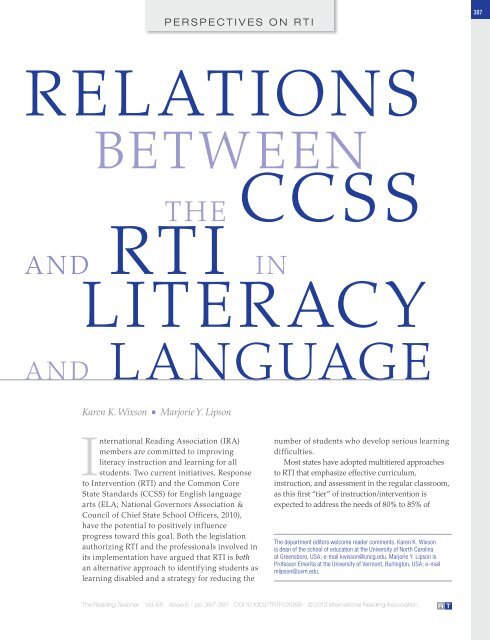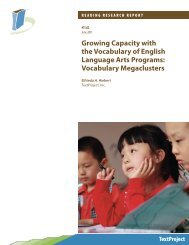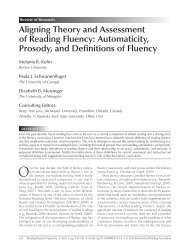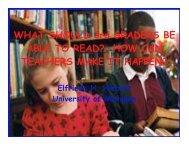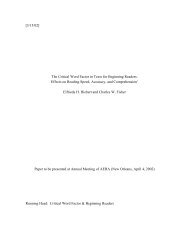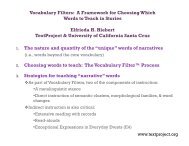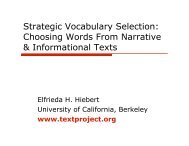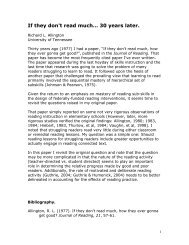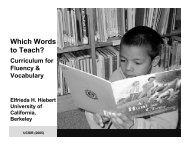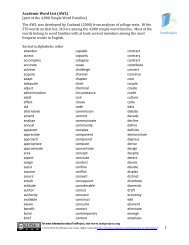Relations Between the CCSS and RTI in Literacy and Language
Relations Between the CCSS and RTI in Literacy and Language
Relations Between the CCSS and RTI in Literacy and Language
Create successful ePaper yourself
Turn your PDF publications into a flip-book with our unique Google optimized e-Paper software.
PERSPECTIVES ON <strong>RTI</strong>387RELATIONSBETWEENTHE <strong>CCSS</strong>AND <strong>RTI</strong> INLITERACYAND LANGUAGEKaren K. Wixson ■ Marjorie Y. LipsonInternational Read<strong>in</strong>g Association (IRA)members are committed to improv<strong>in</strong>gliteracy <strong>in</strong>struction <strong>and</strong> learn<strong>in</strong>g for allstudents. Two current <strong>in</strong>itiatives, Responseto Intervention (<strong>RTI</strong>) <strong>and</strong> <strong>the</strong> Common CoreState St<strong>and</strong>ards (<strong>CCSS</strong>) for English languagearts (ELA; National Governors Association &Council of Chief State School Officers, 2010),have <strong>the</strong> potential to positively <strong>in</strong>fluenceprogress toward this goal. Both <strong>the</strong> legislationauthoriz<strong>in</strong>g <strong>RTI</strong> <strong>and</strong> <strong>the</strong> professionals <strong>in</strong>volved <strong>in</strong>its implementation have argued that <strong>RTI</strong> is bothan alternative approach to identify<strong>in</strong>g students aslearn<strong>in</strong>g disabled <strong>and</strong> a strategy for reduc<strong>in</strong>g <strong>the</strong>number of students who develop serious learn<strong>in</strong>gdifficulties.Most states have adopted multitiered approachesto <strong>RTI</strong> that emphasize effective curriculum,<strong>in</strong>struction, <strong>and</strong> assessment <strong>in</strong> <strong>the</strong> regular classroom,as this first “tier” of <strong>in</strong>struction/<strong>in</strong>tervention isexpected to address <strong>the</strong> needs of 80% to 85% ofThe department editors welcome reader comments. Karen K. Wixsonis dean of <strong>the</strong> school of education at <strong>the</strong> University of North Carol<strong>in</strong>aat Greensboro, USA; e-mail kwixson@uncg.edu. Marjorie Y. Lipson isProfessor Emerita at <strong>the</strong> University of Vermont, Burl<strong>in</strong>gton, USA; e-mailmlipson@uvm.edu.The Read<strong>in</strong>g Teacher Vol. 65 Issue 6 pp. 387–391 DOI:10.1002/TRTR.01058 © 2012 International Read<strong>in</strong>g AssociationR T
388RELATIONS BETWEEN THE <strong>CCSS</strong> AND <strong>RTI</strong> IN LITERACY AND LANGUAGEstudents. Because <strong>the</strong> <strong>CCSS</strong> willdirect <strong>the</strong> content of <strong>the</strong> curriculum,<strong>in</strong>struction, <strong>and</strong> assessment <strong>in</strong> ELAfor students <strong>in</strong> at least <strong>the</strong> 45+ statesthat have adopted <strong>the</strong>m, <strong>the</strong>y will mostcerta<strong>in</strong>ly have a significant impact on<strong>in</strong>struction <strong>and</strong> <strong>in</strong>tervention with<strong>in</strong> an<strong>RTI</strong> approach to teach<strong>in</strong>g <strong>and</strong> learn<strong>in</strong>g.This column explores <strong>the</strong> implicationsof <strong>the</strong> <strong>CCSS</strong>-ELA for <strong>RTI</strong> <strong>in</strong> <strong>the</strong> areas ofliteracy <strong>and</strong> language.BackgroundThe <strong>CCSS</strong>, like most academic contentst<strong>and</strong>ards, are designed to provide aconsistent, clear underst<strong>and</strong><strong>in</strong>g of whatstudents are expected to learn. They aredesigned to be robust <strong>and</strong> relevant to<strong>the</strong> real world, reflect<strong>in</strong>g <strong>the</strong> knowledge<strong>and</strong> skills that our young people needfor success <strong>in</strong> college <strong>and</strong> careers. Theconcept of college <strong>and</strong> career read<strong>in</strong>essis a driv<strong>in</strong>g force beh<strong>in</strong>d <strong>the</strong> <strong>CCSS</strong>.College <strong>and</strong> Career Read<strong>in</strong>ess (CCR)st<strong>and</strong>ards for <strong>the</strong> end of 12th gradewere developed first. These CCRst<strong>and</strong>ards <strong>the</strong>n served as <strong>the</strong> basis for<strong>the</strong> development of <strong>the</strong> k<strong>in</strong>dergartenthrough grade 12 (K–12) st<strong>and</strong>ards,which are <strong>in</strong>tended to function aslearn<strong>in</strong>g progressions that lead toachievement of <strong>the</strong>CCR st<strong>and</strong>ards.The <strong>CCSS</strong>-ELA provide an<strong>in</strong>tegrated view ofliteracy <strong>and</strong> language,highlight<strong>in</strong>g <strong>the</strong> areaswith<strong>in</strong> <strong>the</strong> ELA—read<strong>in</strong>g, writ<strong>in</strong>g,speak<strong>in</strong>g/listen<strong>in</strong>g,<strong>and</strong> language. ForK–5, <strong>the</strong> read<strong>in</strong>g <strong>and</strong>writ<strong>in</strong>g str<strong>and</strong>s arefur<strong>the</strong>r del<strong>in</strong>eated bytext type—literature<strong>and</strong> <strong>in</strong>formational.The grade 6–12st<strong>and</strong>ards are first organized by ELA<strong>and</strong> subject matter to dist<strong>in</strong>guishwhich st<strong>and</strong>ards are <strong>the</strong> responsibilityof <strong>the</strong> ELA teacher <strong>and</strong> which are tobe addressed by subject area teachers.With<strong>in</strong> <strong>the</strong> ELA portion of <strong>the</strong> grade6–12 st<strong>and</strong>ards, <strong>the</strong> organization issimilar to that of <strong>the</strong> K–5 st<strong>and</strong>ards(i.e., all four areas of <strong>the</strong> languagearts, with read<strong>in</strong>g <strong>and</strong> writ<strong>in</strong>g brokendown by literature <strong>and</strong> <strong>in</strong>formational).In contrast, <strong>the</strong> subject area sectionsaddress only read<strong>in</strong>g <strong>and</strong> writ<strong>in</strong>g, <strong>and</strong><strong>the</strong>se areas are broken down accord<strong>in</strong>gto history/social studies <strong>and</strong> science/technical subjects.<strong>RTI</strong> is focused on determ<strong>in</strong><strong>in</strong>gwhe<strong>the</strong>r students are respond<strong>in</strong>gto <strong>in</strong>struction <strong>and</strong> <strong>in</strong>tervention <strong>in</strong>a manner that <strong>in</strong>dicates <strong>the</strong>y arega<strong>in</strong><strong>in</strong>g <strong>the</strong> knowledge <strong>and</strong> skillscharacteristic of mature, effectivereaders. The <strong>CCSS</strong>-ELA documentdescribes mature, effective readers <strong>in</strong><strong>the</strong> form of a “vision” of what it meansto be literate <strong>in</strong> <strong>the</strong> 21st century (p. 3)<strong>and</strong> a “portrait” of what students whoare college <strong>and</strong> career ready <strong>in</strong> ELA“look like” (p. 7). The vision statementemphasizes that students who meet <strong>the</strong>ELA st<strong>and</strong>ards “readily undertake <strong>the</strong>close, attentive read<strong>in</strong>g that is at <strong>the</strong>heart of underst<strong>and</strong><strong>in</strong>g <strong>and</strong> enjoy<strong>in</strong>gcomplex” texts, <strong>and</strong> “habitually perform<strong>the</strong> critical read<strong>in</strong>g necessary to pickcarefully through <strong>the</strong> stagger<strong>in</strong>gamount of <strong>in</strong>formation availabletoday.” Fur<strong>the</strong>rmore, “<strong>the</strong>y activelyseek <strong>the</strong> wide, deep, <strong>and</strong> thoughtfulengagement with high-quality literary<strong>and</strong> <strong>in</strong>formational texts that buildsknowledge, enlarges experience, <strong>and</strong>broadens world views.”The portrait of students who meet <strong>the</strong>St<strong>and</strong>ards <strong>in</strong>cludes several attributescommonly identified as good habits<strong>in</strong> <strong>the</strong> areas of ELA—attributes suchas (a) demonstrat<strong>in</strong>g <strong>in</strong>dependence;(b) build<strong>in</strong>g strong content knowledge;(c) respond<strong>in</strong>g to <strong>the</strong> vary<strong>in</strong>gdem<strong>and</strong>s of audience, task, purpose,<strong>and</strong> discipl<strong>in</strong>e; (d) comprehend<strong>in</strong>g aswell as critiqu<strong>in</strong>g; (e) valu<strong>in</strong>g evidence;(f) us<strong>in</strong>g technology <strong>and</strong> digitalmedia; <strong>and</strong> (g) underst<strong>and</strong><strong>in</strong>g o<strong>the</strong>rperspectives <strong>and</strong> cultures. In short,<strong>the</strong> emphasis on college <strong>and</strong> careerread<strong>in</strong>ess <strong>in</strong> <strong>the</strong> <strong>CCSS</strong>-ELA raises <strong>the</strong>bar for what students are expected to“Because <strong>the</strong> <strong>CCSS</strong> will direct <strong>the</strong> content of<strong>the</strong> curriculum, <strong>in</strong>struction, <strong>and</strong> assessment <strong>in</strong>ELA...<strong>the</strong>y will most certa<strong>in</strong>ly have a significantimpact on...an <strong>RTI</strong> approach.”R TThe Read<strong>in</strong>g Teacher Vol. 65 Issue 6 March 2012
390RELATIONS BETWEEN THE <strong>CCSS</strong> AND <strong>RTI</strong> IN LITERACY AND LANGUAGEAccord<strong>in</strong>g to <strong>the</strong>se claims, students areexpected to do <strong>the</strong> follow<strong>in</strong>g:■ Read closely <strong>and</strong> critically to comprehenda range of <strong>in</strong>creas<strong>in</strong>glycomplex literary <strong>and</strong> <strong>in</strong>formationaltexts■ Produce effective writ<strong>in</strong>g for arange of purposes <strong>and</strong> audiences■ Employ effective speak<strong>in</strong>g <strong>and</strong> listen<strong>in</strong>gskills for a range of purposes<strong>and</strong> audiences■ Engage appropriately <strong>in</strong> collaborative<strong>and</strong> <strong>in</strong>dependent <strong>in</strong>quiry to<strong>in</strong>vestigate/research topics, posequestions, <strong>and</strong> ga<strong>the</strong>r <strong>and</strong> present<strong>in</strong>formation■ Use oral <strong>and</strong> written languageskillfully across a range of literacytasks.Approaches to assessment <strong>in</strong> <strong>RTI</strong> willneed to encompass a wide range of measuresto address <strong>the</strong> breadth <strong>and</strong> depthof <strong>the</strong> content expectations <strong>in</strong> <strong>the</strong> <strong>CCSS</strong>-ELA. Educators should anticipate thatmany students, even those who areaccurate <strong>and</strong> fluent, might not fare wellon <strong>the</strong>se assessments.InstructionThere is little doubt that <strong>the</strong>re will be agreater need for <strong>in</strong>tegrated <strong>in</strong>structionto address <strong>the</strong> <strong>CCSS</strong>-ELA emphasison higher order skills, <strong>in</strong>creased contentknowledge, <strong>and</strong> ability to engage withcomplex texts. For example, <strong>the</strong> PARCCconsortium has released ModelContent Frameworks for ELA/<strong>Literacy</strong>(PARCC, 2011), which consist offour <strong>in</strong>structional modules per gradelevel (grades 3–8 <strong>and</strong> high school).These modules are designed to bothreflect key elements of <strong>the</strong> <strong>CCSS</strong>-ELA<strong>and</strong> support <strong>the</strong> development of <strong>the</strong>assessments.As such, each module is structuredso that students read complex texts<strong>and</strong> analyze, research, write, <strong>and</strong>speak about a variety of <strong>the</strong>se textsthroughout <strong>the</strong> four-module sequence.This <strong>in</strong>cludes <strong>the</strong> use of grade b<strong>and</strong>levelcomplex text (leveled textsthat are below grade b<strong>and</strong> level <strong>in</strong>complexity cannot be a substitute,because <strong>the</strong> st<strong>and</strong>ards <strong>in</strong>dicate thatstudents should be read<strong>in</strong>g gradeb<strong>and</strong>-level complex text) <strong>and</strong> <strong>the</strong> use of<strong>in</strong>formational text <strong>in</strong> elementary school<strong>and</strong> literary nonfiction <strong>in</strong> secondaryELA classes, along with build<strong>in</strong>gexpertise <strong>and</strong> experience regard<strong>in</strong>g atopic or concept.The proposed modules beg<strong>in</strong> withgrade 3, but it is clear that studentswill need a different type of beg<strong>in</strong>n<strong>in</strong>gread<strong>in</strong>g <strong>in</strong>struction to be preparedfor <strong>the</strong> type of <strong>in</strong>tegrated <strong>in</strong>structionjust described. Beg<strong>in</strong>n<strong>in</strong>g read<strong>in</strong>g<strong>in</strong>struction will need to help studentsga<strong>in</strong> control of early read<strong>in</strong>g skills asquickly as possible <strong>and</strong> prepare <strong>the</strong>m for<strong>the</strong> <strong>in</strong>tegrated <strong>in</strong>struction expected <strong>in</strong>upper grade levels.These goals are embodied <strong>in</strong>an approach such as <strong>the</strong> researchbasedInteractive Strategies Approach(Scanlon, Anderson, & Sweeney, 2010),which teaches children, <strong>in</strong>clud<strong>in</strong>g thosewho are struggl<strong>in</strong>g with language <strong>and</strong>literacy, to use what <strong>the</strong>y have learned<strong>in</strong>dependently <strong>and</strong> flexibly. This type ofearly literacy <strong>in</strong>struction is essential ifstudents are to succeed with <strong>the</strong> morechalleng<strong>in</strong>g texts <strong>and</strong> tasks that layahead.Higher expectations are likely toresult <strong>in</strong> even greater variability <strong>in</strong>student performance <strong>and</strong> <strong>in</strong>creasedneed for differentiated approachescharacterized by <strong>RTI</strong>. The ModelContent Frameworks make it clear thatto succeed on <strong>the</strong> PARCC assessments,students need to have opportunitiesfor <strong>in</strong>dependent read<strong>in</strong>g of a widerange of materials on a variety oftopics. Such <strong>in</strong>dependent read<strong>in</strong>gmust <strong>in</strong>clude texts at <strong>the</strong> read<strong>in</strong>glevel of students as well as texts withcomplexity levels that will challenge <strong>and</strong>motivate <strong>the</strong>m.Although <strong>the</strong> PARCC Draft ModelContent Frameworks released <strong>in</strong>“Higher expectations are likely to result <strong>in</strong> evengreater variability <strong>in</strong> student performance <strong>and</strong><strong>in</strong>creased need for differentiated approachescharacterized by <strong>RTI</strong>.”R TThe Read<strong>in</strong>g Teacher Vol. 65 Issue 6 March 2012
391RELATIONS BETWEEN THE <strong>CCSS</strong> AND <strong>RTI</strong> IN LITERACY AND LANGUAGEAugust 2011 stated that “some studentswill need additional scaffold<strong>in</strong>g <strong>and</strong>coord<strong>in</strong>ated <strong>in</strong>terventions designed toaccelerate <strong>the</strong>ir development toward<strong>the</strong> <strong>in</strong>dependent read<strong>in</strong>g of gradelevelcomplex texts” (p. 6), no suchstatement appears <strong>in</strong> <strong>the</strong> f<strong>in</strong>al versionof <strong>the</strong> Model Content Frameworks,released <strong>in</strong> November 2011. We believethat this will be essential for successfulimplementation of <strong>the</strong> <strong>CCSS</strong>-ELA, <strong>and</strong>that schools will need to provide a muchwider array of learn<strong>in</strong>g opportunities forstudents identified as struggl<strong>in</strong>g than isavailable <strong>in</strong> many approaches to <strong>RTI</strong>.Look<strong>in</strong>g AheadIRA members are uniquely positionedto provide leadership <strong>in</strong> <strong>the</strong> complexpolicy arena of <strong>RTI</strong> <strong>and</strong> <strong>CCSS</strong>. The <strong>RTI</strong>Guidel<strong>in</strong>es adopted by IRA lay out <strong>the</strong>elements for a successful approach—onethat is systemic <strong>and</strong> preventative. Help<strong>in</strong>gstudents to be successful early on meansthat <strong>the</strong>y are likely to spend more time<strong>in</strong> <strong>the</strong> core classroom, where <strong>the</strong>y willexperience <strong>the</strong> rigorous <strong>and</strong> excit<strong>in</strong>gcurriculum envisioned by <strong>CCSS</strong>-ELA.Our approaches to prevention,however, are unlikely to succeed if<strong>the</strong>y are too narrow. They need toaddress <strong>the</strong> entire range of knowledge<strong>and</strong> skills necessary to succeed <strong>in</strong> <strong>the</strong>curricula, <strong>in</strong>structional approaches,<strong>and</strong> assessments emerg<strong>in</strong>g fromimplementation of <strong>the</strong> <strong>CCSS</strong>-ELA.Fur<strong>the</strong>r, effective early <strong>in</strong>tervention/prevention is critical if we do not want tostr<strong>and</strong> a whole segment of our studentpopulation, isolat<strong>in</strong>g <strong>the</strong>m from <strong>the</strong>dem<strong>and</strong><strong>in</strong>g <strong>and</strong> important curriculumpromoted by <strong>CCSS</strong>-ELA.REFERENCESIRA. (2010). Response to Intervention: Guid<strong>in</strong>gpr<strong>in</strong>ciples for educators from <strong>the</strong> InternationalRead<strong>in</strong>g Association. Newark, DE: Author.Retrieved November 1, 2010, fromwww. read<strong>in</strong>g.org/Libraries/Resources/<strong>RTI</strong>_brochure_web.sflb.ashxJohnston, P. (2010). An <strong>in</strong>structional frame for<strong>RTI</strong>. The Read<strong>in</strong>g Teacher, 63(7), 602–604.doi:10.1598/RT.63.7.8Lipson, M.Y., & Wixson, K.K. (Eds.). (2010).Successful approaches to <strong>RTI</strong>. Newark, DE:International Read<strong>in</strong>g Association.National Governors Association & Councilof Chief State School Officers. (2010,June). Common core state st<strong>and</strong>ardsfor English language arts & literacy <strong>in</strong>history/social studies, science, <strong>and</strong>technical subjects. Retrieved August14, 2011, from www. corest<strong>and</strong>ards.orgPartnership for Assessment for Read<strong>in</strong>essfor College <strong>and</strong> Careers (PARCC).(2011, August). PARCC draftmodel content frameworks for ELAliteracy.Retrieved September 15,2011, from www.parcconl<strong>in</strong>e.org/parcc-content-frameworksPartnership for Assessment for Read<strong>in</strong>essfor College <strong>and</strong> Careers (PARCC). (2011,November). PARCC model content frameworksfor ELA-literacy. Retrieved December26, 2011, from www.parcconl<strong>in</strong>e.org/parcc-content-frameworksScanlon, D.M., Anderson, K.L., & Sweeney,J.M. (2010). Early <strong>in</strong>tervention for read<strong>in</strong>gdifficulties: The <strong>in</strong>teractive strategies approach.New York: Guilford.Smarter Balanced Assessment Consortium(SBAC). (2011, August 9). Review draft:Content specifications with contentmapp<strong>in</strong>g for <strong>the</strong> summative assessmentof <strong>CCSS</strong>-ELA. Retrieved September 27,2011 from www.k12.wa.us/smarter/Resources.aspxWixson, K.K., & Valencia, S.W. (2011).Assessment <strong>in</strong> <strong>RTI</strong>: What teachers <strong>and</strong>specialists need to know. The Read<strong>in</strong>gTeacher, 64(6), 466–469. doi:10.1598/RT.64.6.13www.read<strong>in</strong>g.orgR T


